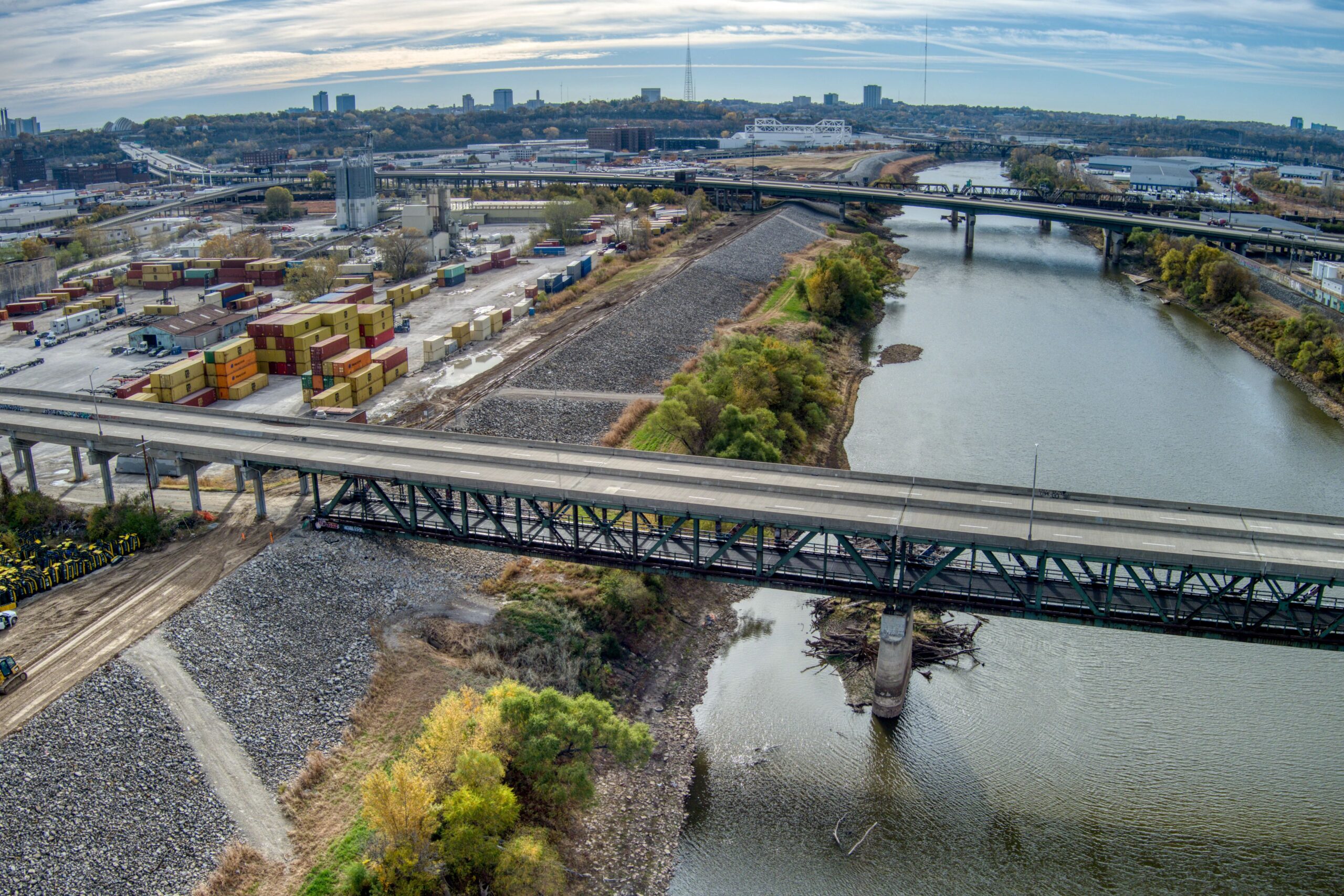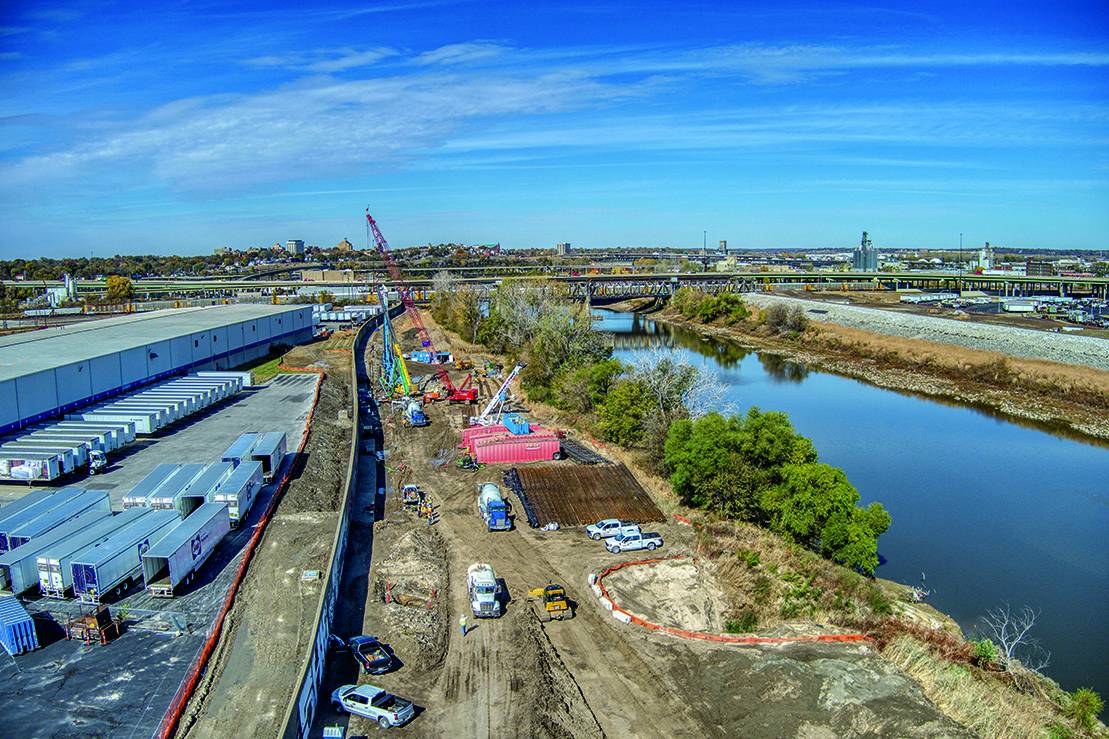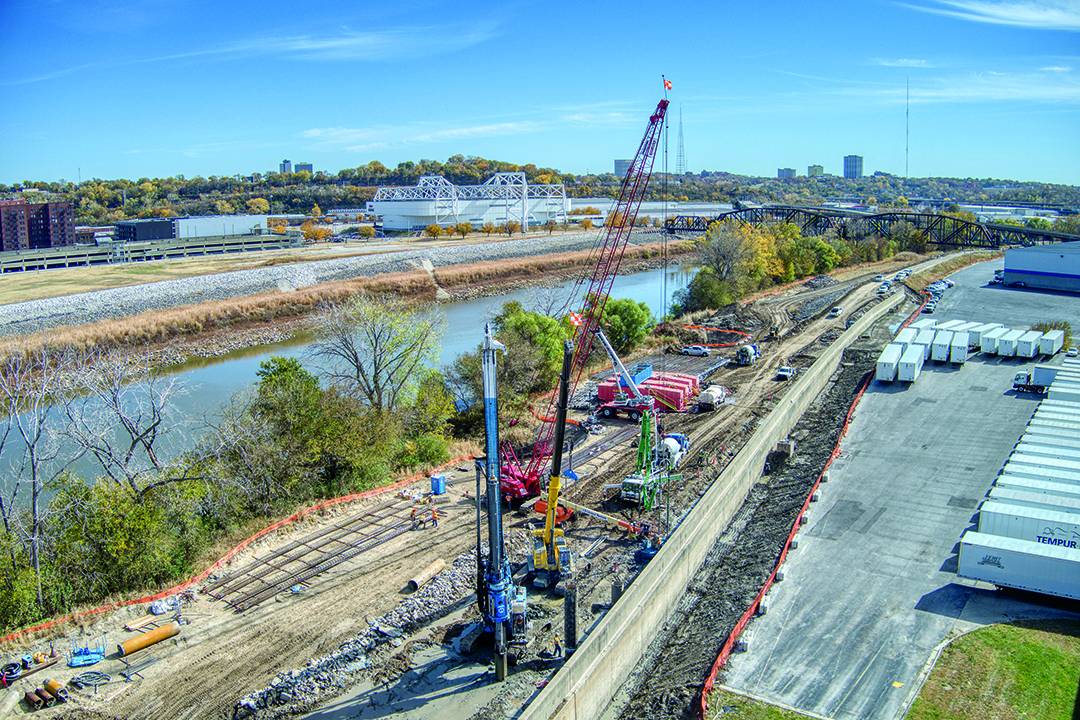
A history of flooding and a near disaster drive elevated water-management measures
DESIGNER
2023
The Argentine, Armourdale and Central Industrial District areas in Kansas City, Missouri, and Kansas City, Kansas, form a crucial national transportation hub key to moving goods throughout the nation.
It includes the Kansas City Terminal Railway, a joint operational center for numerous Class I railroads, including BNSF, Union Pacific, Canadian Pacific Kansas City and Norfolk Southern Railway as well as many other Class II and III railroad carriers and Amtrak.
Nestled in the crook of the Missouri and Kansas rivers, the area has endured persistent flooding problems there for decades, and one of the most serious and potentially devastating events occurred in 1993, when crests reached mere inches below some levee units. Overtopping or a levee breach would have been disastrous.
“The existing levees and floodwalls held and performed as designed,” said Tom Poer, HNTB project director. “But there was more than $3 billion worth of infrastructure in that area that could have been impacted.”
The KC Levees Program is an ambitious, ongoing project designed to further reduce the risk of flooding to these areas that are so economically vital to so many stakeholders. The bistate program between Kansas and Missouri was supported by 100% federal funding and created in partnership with the United States Army Corps of Engineers. Besides flood protection, the initiative was charged with minimally impacting the rail companies’ operations, a daunting task given the scale of the associated operational, financial and scheduling considerations.
Identifying constraints early on allowed the development of robust and risk informed mitigation strategies, and prompt, clear and precise feedback drove thorough, mutually informed submittals and communications. Designated as a fast-track program, it required significant resources and expertise from a variety of disciplines at HNTB, including structural, geotechnical, mechanical, electrical, civil and hydrology and hydraulics.
Size, Scale and Scope
- Raising and improving 17 miles of levees
- Installing 12 railroad closure structures
- Raising 4 bridges above critical flood levels
- Repairing 11 pumping stations
- Installing 300 relief wells
- Relocating or modifying 200+ utilities across and under 5 existing mainline rail tracks
When completed, the KC Levees Program will raise and improve 17 miles of levees, repair 11 pumping stations and completely replace two others. Approximately 130 relief wells will be installed, and more than 200 utilities will be relocated or modified, which includes those across and under five existing mainline tracks. HNTB designed 12 closure structures, which are breaks in a levee or floodwall where railroad tracks or a roadway pass through and a temporary floodwall is installed during a flood event. These structures are being constructed across tracks owned and operated by the BNSF and Union Pacific railroads and the Kansas City Terminal.
The project includes full replacement of an existing stoplog structure at one end of the BNSF Railway’s Argentine Yard and construction of a new stoplog structure, including an H-pile foundation, concrete sill, concrete floodwalls, modifications at two hump leads and an industrial track that services local businesses. The project also includes modifications to two Union Pacific Railroad bridges and a third bridge by Kansas City Terminal railroad to raise above the projected flood levels.



Every day, more than 2,100 railcars arrive and depart the Argentine Yard, which is the second busiest U.S. rail center.
“The risk for significant impacts to railroad operations at 12 high traffic locations and limiting impacts to property owners adjacent to and within the project footprint were easily some of the most challenging obstacles we faced on KC Levees,” says Scott Mensing, KC Levees program manager, USACE, Kansas City District.
A powerful partnership
One of the most integral aspects of the program has been the collaboration with the USACE. The scope of the undertaking also demonstrated the importance of robust advocacy work and building genuine, mutually beneficial relationships, including with the Missouri and Associated Rivers Coalition. The USACE provided technical and design assistance while HNTB delivered the resources and expertise to implement the project. It was a dynamic exercise in collaborative problem-solving that drove innovative solutions to numerous complex design, construction and logistical challenges.
Notable innovative solutions include the strategic placement of floodwalls set back behind the existing floodwalls. This approach built resiliency and saved significant construction costs by not modifying the existing floodwall as well as providing a temporary flood protection solution to the contractor during construction. Another innovative solution included the probability of structure failure analysis method to determine the suitability to re-use the existing gatewell structures. This approach was applied to existing gatewells to determine the annual exceedance probability (AEP) for the structures to ensure safety while economically advancing the structure design.
“There are big components in this program, and an absolutely incredible partnership with USACE Kansas City District, the Unified Government of Wyandotte County and Kansas City, Kansas, the Kaw Valley Drainage District, and the City of Kansas City, Missouri where together we built a level of trust that I’ve never seen before,” Poer said.
Innovations included maintaining temporary flood protection while building new structures. An approach was developed that allowed HNTB to build new floodwalls behind the existing ones.
“Rather than construct a patchwork on the existing floodwalls, which had some uncertainty around them, we were able to build new, higher walls that saved in terms of cost and time,” Poer said. “That allowed us to maintain the existing level of protection during construction.”
17 miles of stakeholders
The amount of coordination required to keep businesses open, operations running and residential property protected along the 17 miles of levees that the project encompassed represented a triumph of communication and goodwill.
Advanced planning and community outreach by the USACE eased the way, and thoughtful community engagement meant that there were only two takings along the entire project corridor. This low number of takings was primarily influenced by including property owners in the design process and tasking the design team to prioritize minimizing impacts to existing infrastructure.
“Early and consistent engagement with property and business owners along the corridor allowed the team to build relationships and include stakeholders in the design process. This allowed the team to build trust, manipulate the design to minimize impacts and communicate benefits of the project,” Mensing explained. “Our relationships and partnerships with the hundreds of stakeholders along the project has been a tremendous success and we are extremely appreciative of their support.”
More than that, the KC Levees Program has come to serve as a model for other infrastructure projects, especially those in flood prone regions. Also, it demonstrated how integral close collaboration between the public and private sectors, including a wide range of businesses, industries and residents, each representing a vast array of concerns, can — and should — be to the success of a program. Advocacy around funding and a long-running working partnership with the USACE and HNTB, helped ensure the project’s completion on time and within budget.
“Close communication and collaboration between HNTB, USACE, the railroads, and all stakeholders allowed us to deliver this program to the community on an extremely aggressive schedule. The sooner we complete the improvements, the faster we can further reduce the risk of flooding to the community,” Mensing said. “It’s amazing to sit back and reflect on the incredible amount of high-quality work that has been completed in such a short amount of time.”
Improving Reliability and Resiliency
The $529 million KC Levees flood management program improved the reliability and resiliency of crucial disaster barriers. It reduced the likelihood of flooding — and its impact on the approximately 30,000 people who live and work in the area — by 200% as well as impact on more than $10 billion in investments and infrastructure in one of the nation’s most critical warehouse, distribution, transportation and railroad hubs.
The project has demonstrated the resiliency and ingenuity of a community of stakeholders faced with maintaining and protecting an array of interests. Changing patterns are affecting crucial industrial sectors in geographic areas that are increasingly vulnerable to natural disasters, including widescale economic devastation when those disasters occur. The KC Levees Program has provided a long needed and much improved level of protection and, with it, a far-reaching sense of security for innumerable stakeholders.
SEE MORE ARTICLES
MORE DESIGNER STORIES
Fish Passage
Dallas Love Field
CID Green Infrastructure Project
I-4 Ultimate
Denver International Airport
